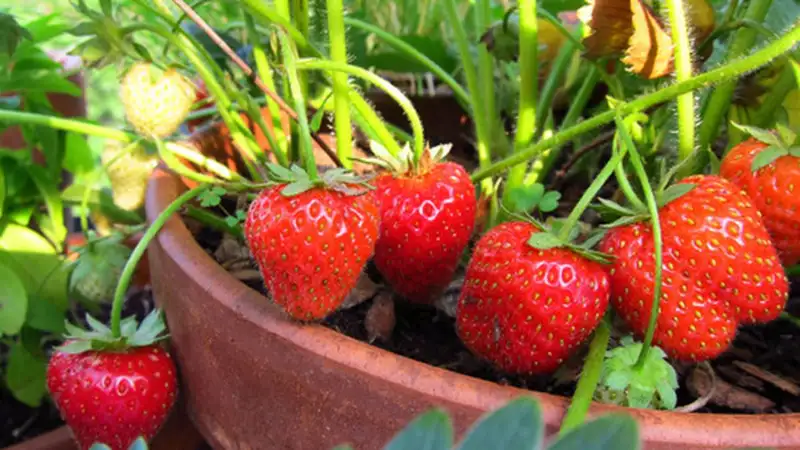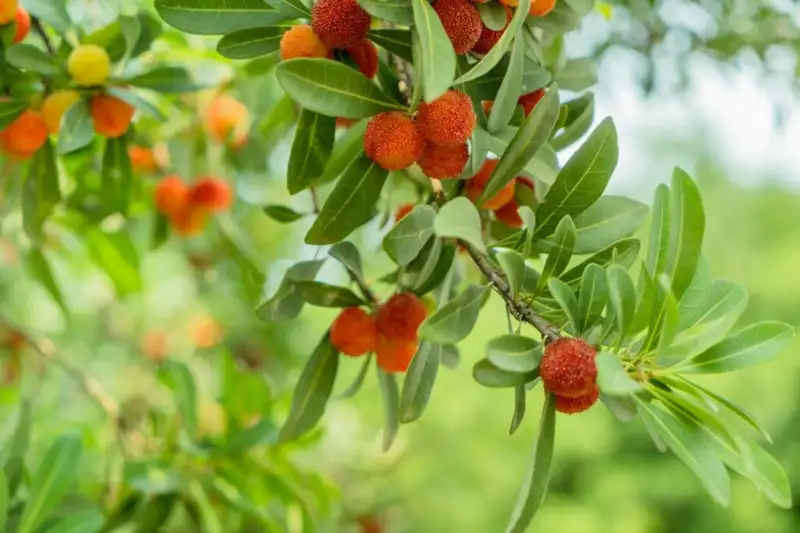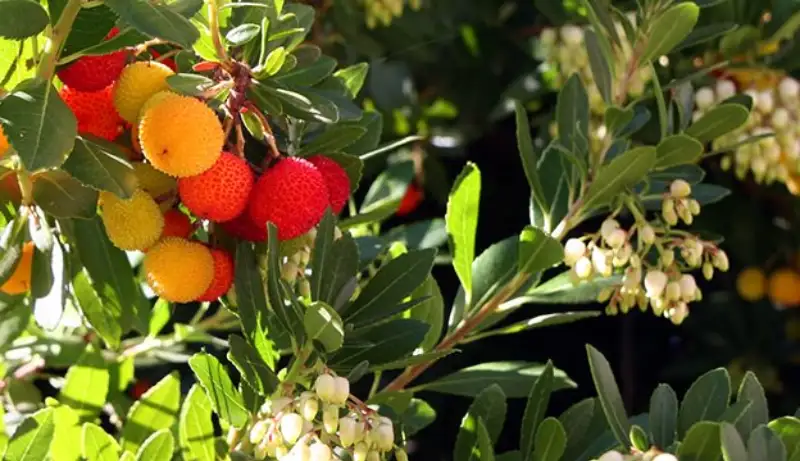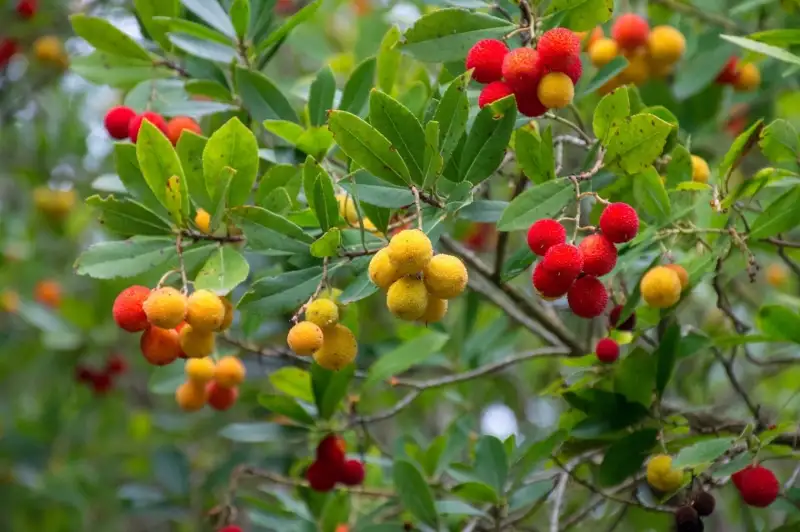Have you recently ENCOUNTERED a strawberry tree? Now you may be thinking, does strawberry grow on trees?
While you may feel PUZZLED about whether strawberries grow on trees? NO SWEAT, my friend – LOTS of people feel the same way!
At AsterGardening, we’ve got your back. We have written this ARTICLE to clear up any confusion about the Strawberry tree.
And, of course, to give you some excellent tips on GROWING and CARING for your berries.
Ready to dive in? We will cover from the BASICS (like what the HECK a strawberry tree even is) to the NITTY-GRITTY details.
Give it a read; you’ll be a BONA-FIDE strawberries trees expert. Trust us; it’s going to be REWARDING.

Strawberry tree: origin and characteristics

The strawberry tree is a SMALL evergreen tree native to the Mediterranean region. It is a pretty COOL moderate-growth rate plant from the heather family!
Do you know why? Because of its EVERGREEN leaves and CLUSTERS of white flowers that BLOOM in the fall.
The fruit of the Strawberry tree is edible! But, few people eat it because it has an ASTRINGENT TASTE.
Do you know how TALL a mature size strawberry tree can get? Pretty tall – up to 20 feet – so make sure you have enough space for it to STRETCH OUT.
But wait, there’s more! The Strawberry tree has MEDICAL value. The leaves CURE urinary tract infections. Not the end of the list, as FRUIT can reduce common cold symptoms.
Suggested reading: Top 14 Strawberry Variety: Explore All The Juice
Does strawberry grow on trees?

OH, NOPE! Strawberries don’t grow on trees, my friend. They’re LOW-GROWING edible fruit plants that spread out and root.
But a tree called the STRAWBERRY TREE can produce fruit like strawberries. They’re SMALL and ROUND, like a strawberry’s color and texture.
But boy, oh boy, they have a different FLAVOR. They’re SWEET and a little TART and taste like a mix of strawberry and fig.
Now you know the similarities. Where do they differ?
Edible berries are SOFT and JUICY, while the strawberry tree fruit is firmer and drier. Also, strawberry trees are common around the Mediterranean area in the WILD.
Top species of strawberry trees

GUESS WHAT? Different types of strawberry trees produce fruits that look and taste LIKE fruits!
Cool, right? Here are some of the TOP species that you need to know about:
1. Arbutus unedo
This drought-tolerant shrub or small tree is from the Mediterranean. Its FRUITS are tasty and slightly sour, with a texture and shape like fruits.
This cane apple strawberry tree is FAMOUS for bearing many bell-shaped flowers. You can eat Irish strawberry tree FRESH or use the fruits to make jam, jelly, or wine. Yum!
2. Arbutus menziesii
Also known as the Pacific madrone, this SPECIES is from North America’s western coast.
Its FRUITS are red and a bit grainy. While they’re not as tasty as Arbutus unedo, they’re still TASTY! They are eaten raw or used to make syrup or tea.
3. Arbutus andrachne
This single-trunk tree strawberry is from the Middle East. It has SMALL, RED fruits that are even sweeter than those of Arbutus menziesii. They’re PERFECT for snacking or making jam or juice.
4. Arbutus xalapensis
This strawberry tree is from Mexico. It bears fruit similar to Arbutus unedo’s fruits. The berries are SMALL and bright red.
You can find this strawberry tree in TRADITIONAL Mexican desserts and candies. DELICIOUS!
5. Arbutus canariensis
This small tree species bearing white flowers is from the Canary Islands. It has LARGER red or orange fruits that are sweet and a little sour.
They’re great to eat fresh or USE in jam or liqueur. They GROW in late winter hardiness zone 7-9 with full sun.
6. Muntingia calabura
This dalmatian strawberry tree is also FAMOUS for Jamaican cherry. The tree grows in full sun or partial shade, bearing white flowers.
This Jamaican cherry species is slightly DROUGHT TOLERANT with a normal trunk diameter. Growing in hardiness zones 9-10, its red berries (cotton candy) are healthier fruit.
How to plant strawberry trees?

Do you want to PLANT a yummy and colorful dalmatian strawberry tree in your garden? That sounds BERRY exciting!
But beware, planting it might ATTRACT sneaky squirrels who can STEAL your berries. So, keep an eye out for those RASCALS!
1. Choose the Right Planting Site
First, you must CHOOSE a spot with partial sun exposure and well-drained soil.
Don’t be fooled by the shade. These garden plants also need their daily DOSE of Vitamin D from sun exposure! And speaking of soil, make sure to plant in ACIDIC to slightly ALKALINE medium!
2. Prepare the Growth Medium
Now, let’s get PLANTING! It’s time to give the dalmatian strawberry tree the royal treatment it deserves.
Give it some well-rotted manure or maybe even some disco music to get it in the grooving MOOD!
3. Proper Plant Spacing
Plant SPACING matters for ornamental use or hedging. This plant GROWS faster, so keep spacing optimized for partial sun.
Select the planted spacing according to the strawberry tree variety RECOMMENDATION. For instance, Arbutus unedo can take up LESS space than other varieties.
4. Choose the Right Fertilizer
To help your planted strawberry tree grow healthy, consider hiring a nutritionist.
Okay, not that EXTREME, but make sure to FEED it regularly. Feed it some delicious 10-10-10 fertilizer. Don’t go OVERBOARD and turn it into a bodybuilder!
5. Water Regularly
Remember to keep your strawberry tree HYDRATED! Think of it like your thirsty friends on a hot summer day; they need water!
But be careful not to get the leaves wet for LONG. Unless you want your plants to sing “I’m singing in the rain” all day!
6. Trim Them
If your strawberry tree starts feeling like Rapunzel, it might be time for a TRIM!
Just be gentle and don’t CUT OFF more than it can handle, or it might look like a botched haircut. YIKES!
7. Avoid Pests
If you want to PROTECT your precious berries from pesky birds, consider using NETTING. It will prevent birds from attacking the seed and blooms.
And if you spot any BUGS, don’t panic! Give them a spa treatment with some INSECTICIDAL SOAP or NEEM OIL.
Caring tips for strawberry trees

If you’re LUCKY enough to have a strawberry tree in your YARD, you want to take good CARE of it, right?
Because, let’s face it, a dead tree is not a good look for anyone’s YARD. Except you like a spooky and haunted forest vibe!
So, let’s talk about some TIPS that can help your tree stay healthy and vibrant. Follow them to avoid confusion growing tall strawberry trunks and branches.
1. Water
First things first, let’s talk about WATERING the seedlings. These trees love a GOOD drink, like your crazy aunt Karen at a family reunion.
But don’t overdo it because ROOT ROT is not fun for anyone. A strawberry tree becomes drought resistant as MATURE. So, the first year is CRUCIAL for water.
2. Fertilizer
Next up, FERTILIZING. Give your tree a good FEEDING in the springtime with a slow-release fertilizer.
Avoid fertilizers that are HIGH in phosphorus. Unless you want your tree to start experimenting with its version of the “HULK SMASH!”
3. Pruning
Your tree needs a LITTLE trimming to keep its shape and size in check.
It’s like getting a haircut. If you wait too long, you’ll look like Cousin It from The Addams Family. And nobody WANTS that except maybe Cousin It himself.
4. Pests and Disease
Keep an eye out for PESTS and DISEASES too. They can mess up your tree’s vibe. Check for CREEPY crawlies like aphids, spider mites, and scale insects.
If you spot anything, use natural insecticide or fungicide to CONTROL it. Or just hire a tiny HITMAN to take care of the problem.
5. Mulch
Last but not least, let’s MULCH! Add some organic mulch, like shredded leaves or bark, around the base of your tree.
It will HELP keep the moisture in summer and STOP any pesky weeds from taking over. It’ll give your tree that cozy, hygge feeling everyone’s talking about.
FAQs about Does Strawberry Grow On Trees
1. Where do strawberry trees grow best?
Strawberry trees are native to the Mediterranean. But can be grown in areas with similar climates. These fruits prefer mild winters and hot, dry summers and are adapted to grow in well-draining soil.
Most species (including arbutus unedo and the Killarney strawberry tree) can be grown in USDA Hardiness Zones 7 through 10.
2. Are strawberries on a vine?
No, strawberries are not grown on vine-like grapes. Instead, they grow on short stems that emerge from the base of the plant and are usually close to the ground. These stems, also known as runners, can produce new plants if allowed to take root.
3. Can you grow a strawberry tree in pots?
Growing a strawberry tree in a pot is possible but requires a large container for the root system. A pot that is too small can lead to stunted growth and poor health.
4. Are strawberry trees hard to grow?
A strawberry tree can be challenging to grow, requiring specific conditions and maintenance. However, it can thrive with proper care and attention. The strawberry tree requires regular watering, fertilizing, and pruning to stay healthy.
What’s Next
Strawberry trees are pretty COOL! They’re from the Mediterranean. They have characteristic SHINY leaves and bark that PEEL OFF, giving them a unique look.
You want to pick a spot with GOOD DRAINAGE and soil for the Strawberry tree. It doesn’t like to have “wet feet,” so ensure the soil isn’t too heavy or clay-like.
Ensure REGULAR watering and fertilization to help it grow strong and healthy. And remember to PRUNE.
Want to take your GARDENING game up a notch? Check out AsterGardening – The SPOT for garden-related.
We’ve got you covered with planting tips, care guides, and GARDENING know-how that’ll turn you into a pro in no time.
